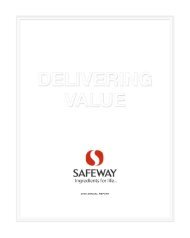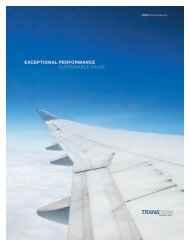Bemis Company 2007 Annual Report - IR Solutions
Bemis Company 2007 Annual Report - IR Solutions
Bemis Company 2007 Annual Report - IR Solutions
Create successful ePaper yourself
Turn your PDF publications into a flip-book with our unique Google optimized e-Paper software.
Taxes on undistributed earnings: No provision is made for U.S. income taxes on earnings of non-U.S. subsidiary companies which the<br />
<strong>Company</strong> controls but does not include in the consolidated federal income tax return as it is management's practice and intent to<br />
indefinitely reinvest the earnings.<br />
Accounting for stock-based compensation: Effective January 1, 2006, the <strong>Company</strong> adopted Statement of Financial Accounting<br />
Standards No. 123(R), Share-Based Payment (FAS 123(R)), which significantly changed accounting practice with respect to employee<br />
stock options. FAS 123(R) requires that the <strong>Company</strong> measure the cost of equity-based service awards based on the grant-date fair value<br />
of the award. The impact of adopting this standard on January 1, 2006, was insignificant to the <strong>Company</strong>’s results of operations since no<br />
new stock option awards have been granted since 2003 and all stock options outstanding at December 31, 2005, are fully or partially<br />
vested. Prior to adopting FAS 123(R), the <strong>Company</strong> applied the recognition and measurement principles of APB No. 25, Accounting for<br />
Stock Issued to Employees. The intrinsic value method is used to account for stock-based compensation plans. If compensation expense<br />
had been determined based on the fair value method with the pro forma compensation expense reflected over the vesting period, net<br />
income and income per share would have been adjusted to the pro forma amounts indicated below:<br />
(in thousands, except per share amounts) 2005<br />
Net income - as reported $162,529<br />
Add: Stock-based compensation expense<br />
included in net income, net of related tax effects 8,655<br />
Deduct: Total stock-based compensation expense under<br />
fair value-based method, net of related tax effects (8,996)<br />
Net income - pro forma $162,188<br />
Basic earnings per share - as reported $ 1.53<br />
Basic earnings per share - pro forma $ 1.52<br />
Diluted earnings per share - as reported $ 1.51<br />
Diluted earnings per share - pro forma $ 1.50<br />
Compensation expense for pro forma purposes was reflected over the vesting period. Note 8 contains the significant<br />
assumptions used in determining the underlying fair value of options.<br />
Cash and cash equivalents: The <strong>Company</strong> considers all highly liquid temporary investments with a maturity of three months or less<br />
when purchased to be cash equivalents. Cash equivalents include certificates of deposit that can be readily liquidated without penalty at<br />
the <strong>Company</strong>’s option. Cash equivalents are carried at cost which approximates market value.<br />
Accounts receivable: Trade accounts receivable are stated at the amount the <strong>Company</strong> expects to collect, which is net of an allowance<br />
for doubtful accounts for estimated losses resulting from the inability of its customers to make required payments. The following factors<br />
are considered when determining the collectibility of specific customer accounts: customer creditworthiness, past transaction history with<br />
the customer, and changes in customer payment terms or practices. In addition, overall historical collection experience, current economic<br />
industry trends, and a review of the current status of trade accounts receivable are considered when determining the required allowance<br />
for doubtful accounts. Based on management’s assessment, the <strong>Company</strong> provides for estimated uncollectible amounts through a charge<br />
to earnings and a credit to valuation allowance. Balances that remain outstanding after the <strong>Company</strong> has used reasonable collection<br />
efforts are written off through a charge to the valuation allowance and a credit to accounts receivable. Accounts receivable are presented<br />
net of an allowance for doubtful accounts of $19,311,000 and $20,287,000 at December 31, <strong>2007</strong> and 2006, respectively.<br />
Inventory valuation: Inventories are valued at the lower of cost, as determined by the first-in, first-out (FIFO) method, or market.<br />
Inventories are summarized at December 31, as follows:<br />
(in thousands) <strong>2007</strong> 2006<br />
Raw materials and supplies $169,687 $169,914<br />
Work in process and finished goods 328,758 316,482<br />
Total inventories, gross 498,445 486,396<br />
Less inventory write-downs (19,718) (18,543)<br />
Total inventories, net $478,727 $467,853<br />
Property and equipment: Property and equipment are stated at cost. Maintenance and repairs that do not improve efficiency or extend<br />
economic life are expensed as incurred. Plant and equipment are depreciated for financial reporting purposes principally using the<br />
straight-line method over the estimated useful lives of assets as follows: land improvements, 15-30 years; buildings, 15-45 years;<br />
leasehold and building improvements, 8-20 years; and machinery and equipment, 3-16 years. For tax purposes, the <strong>Company</strong> generally<br />
uses accelerated methods of depreciation. The tax effect of the difference between book and tax depreciation has been provided as<br />
deferred income taxes. Depreciation expense was $149,852,000, $144,058,000, and $142,599,000 for <strong>2007</strong>, 2006, and 2005, respectively.<br />
On sale or retirement, the asset cost and related accumulated depreciation are removed from the accounts and any related gain or loss is<br />
reflected in income. Interest costs which are capitalized during the construction of major capital projects totaled $4,220,000 in <strong>2007</strong>,<br />
$2,871,000 in 2006, and $993,000 in 2005.<br />
The <strong>Company</strong> reviews its long-lived assets for impairment when events or changes in circumstances indicate that the carrying<br />
amount of the assets may not be recoverable. If impairment indicators are present and the estimated future undiscounted cash flows are<br />
less than the carrying value of the assets, the carrying values are reduced to the estimated fair value.<br />
25







